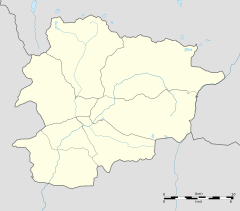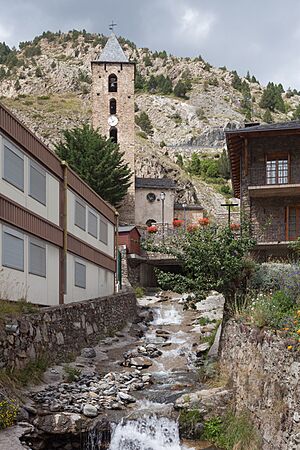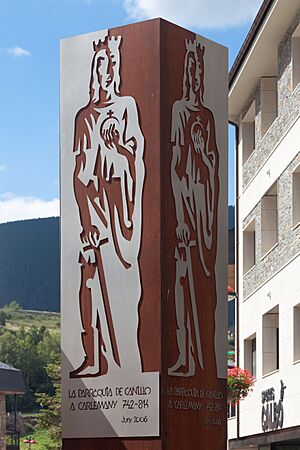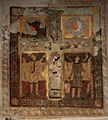Canillo facts for kids
Quick facts for kids
Canillo
|
|||
|---|---|---|---|
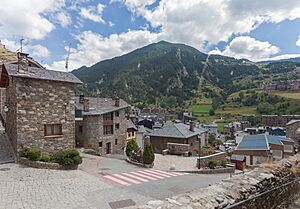
Plaça de Sant Serni and Carrer Major of Canillo.
|
|||
|
|||
| Country | Andorra | ||
| Parishes | Canillo | ||
| Villages | Bordes d'Envalira, El Forn, El Tarter, El Vilar, Els Plans, Incles, L'Aldosa, Meritxell, Molleres, Prats, Ransol, Sant Pere, Soldeu |
||
| Area | |||
| • Total | 121 km2 (47 sq mi) | ||
| Elevation | 1,526 m (5,007 ft) | ||
| Population
(2011)
|
|||
| • Total | 4,826 | ||
| • Density | 42.12/km2 (109.1/sq mi) | ||
| Demonym(s) | canillenc, canillenca | ||
| Website | Official Tourism Office of Canillo: http://www.vdc.ad | ||
Canillo is one of the seven parishes of Andorra. It is also the name of the main town in this parish. Canillo is known as the religious heart of Andorra. It is home to the Sanctuary and Chapel of Our Lady of Meritxell, who is the patron saint of Andorra. The parish also has some of the best-preserved Romanesque churches in the Pyrenees mountains, like Sant Joan de Caselles.
As of 2011, about 4,826 people live in Canillo. Even though many tourists visit, Canillo still has a lot of traditional farming and livestock activities. The parish shares a border with France.
Contents
History of Canillo
The name Canillo comes from a very old language, possibly from the Iberians or Celts. It was first written down in the 9th century as Kanillave. Later, in 1176, it was called Canilau.
In the village of Prats, you can find the Roc de les Bruixes (Witches' Rock). This place has ancient rock carvings from the Bronze Age and Iberian times. It was a sacred spot where people once collected stone powder for special ointments.
Old Christian remains, like burial sites near Sant Joan de Caselles and Sant Serni de Canillo, show that Christianity arrived in Andorra very early, around the 7th and 8th centuries.
Canillo still feels very traditional, like it did in the Medieval Period. You can see old mills and classic mountain houses. The flour mill of the Peano shows how people used to make money. Buildings in the old town, like Ca Armany and Cal Ferrer Nou, also show this history. The old parts of Soldeu and Incles are similar.
The church of Sant Joan de Caselles is a famous Romanesque building from the late 11th century. Inside, there is a Romanesque statue of Christ and a Gothic altarpiece from the 16th century. Other churches in Canillo include Sant Serni (from the 12th century, but mostly Baroque style from the 17th-18th centuries), Sant Miquel de Prats (12th-13th centuries), and Santa Creu de Canillo (built in 1781).
Culture and Legends
Canillo is part of an Andorran legend called El buner d'Ordino. In this story, a bagpiper from another parish is going to a festival in Canillo. Wolves chase him up a tree, but he scares them away by playing his bagpipes.
The parish is also linked to the national legend of Charlemagne. The story says that Charlemagne entered Andorra through the Incles Valley. He supposedly tied his horse to a mountain called Pic Negre of Juclà, marking the border between Andorra and a nearby French area. Near this spot, there is a Creu Gótica de Carlemany (Gothic Cross of Charlemagne), which honors the blacksmiths of the country.
You can also find the Creu dels Set Braços (Cross of the seven arms) in Canillo. This cross is part of a sad legend. A boy from Prats was bringing wine from Canillo. His friends tried to scare him as a joke, but he accidentally killed one of them. The body disappeared, and some say the devil took it. A cross with seven arms was placed there to remind people of the event. One arm of the cross disappeared when one of the seven friends also vanished.
Canillo is home to the Sanctuary of Our Lady of Meritxell. A legend says a shepherd found a statue of the Virgin Mary under some flowering roses in winter. He took it home, but the statue kept returning to the same spot. So, the people of Andorra built a chapel there. In 1873, the General Council of the Valleys declared her the patron saint of Andorra. September 8th is now a national holiday.
The original sanctuary was Romanesque and was rebuilt in the 17th century. Sadly, it burned down in 1972, and the old statue of the Virgin was destroyed. A new sanctuary was built by architect Ricardo Bofill Levi and opened in 1976. A copy of the original statue is now honored inside.
In 2014, the sanctuary was named a Minor basilica by Pope Francis. It is now part of the Marian Route, a special religious path that connects several important Marian sanctuaries in Europe.
Geography of Canillo
Canillo parish includes several villages like Soldeu, Bordes d'Envalira, El Tarter, Sant Pere, Ransol, Els Plans, El Vilar, l'Aldosa, El Forn, Incles, Prats, Meritxell and Molleres. Unlike other parts of Andorra, Canillo is divided into veïnats (neighborhoods). Canillo is the largest parish in Andorra, covering 121 square kilometers (about 47 square miles).
The parish has beautiful natural areas, including the Incles Valley, the Ransol Valley, and the Montaup Valley. In the Incles Valley, you can find the Estany de Juclà, which is the largest lake in Andorra. It covers about 21.3 hectares (0.21 square kilometers).
Climate in Canillo
Canillo has a humid continental climate. This means it has warm summers and cold, snowy winters. The average yearly temperature is about 6.2 degrees Celsius (43.2 degrees Fahrenheit). May is usually the wettest month. The warmest month is July, with an average of 15.0 degrees Celsius (59.0 degrees Fahrenheit). January is the coldest, averaging -1.4 degrees Celsius (29.5 degrees Fahrenheit).
Events and Sports
One of the first celebrations in Canillo each year is Sant Antoni in January. There are traditional markets and a special mountain soup called vianda is shared. The crema del mai (burning of mai) is also celebrated to mark the end of winter. People burn a spruce tree and sing and dance around it.
Carnival, also known as the Harlequin Festival, is another popular event. People wear special harlequin costumes with bells.
In the summer, the Canillo Festival takes place. Part of this festival is the Sheepdog Contest at Planells de Mereig. This contest is part of a larger championship for the Catalan Countries.
Sports in Canillo
The Soldeu-El Tarter area has hosted World Cup ski races several times, including in 2012 and 2016. The World Cup finals were held there in March 2019.
During the summer, Canillo is great for mountain activities. You can go hiking, climbing, or enjoy bike routes in Grand Valira and Vall d'Incles. Canillo also has the highest golf course in Europe, located at 2,250 meters (7,382 feet) high.
The Palau de Gel d'Andorra is a sports and fun center in Canillo. It has facilities for ice skating, ice hockey, and curling. It is also the main office for the Andorran Federation of Ice Sports.
People of Canillo
Most people living in Canillo are Andorran. There are also many people from Spain and Portugal. As of 2013, the largest groups of foreign residents in Canillo were:
| Rank | Nationality | Population (2013) |
|---|---|---|
| 1 | 1,201 | |
| 2 | 542 | |
| 3 | 433 | |
| 4 | 147 | |
| 5 | 110 |
Famous People from Canillo
- Carles Font-Rossell (born 1967) was Andorra's Ambassador to the United States and its representative to the United Nations.
- Xavier Capdevila Romero (born 1976) is an Andorran ski mountaineer.
- Marc Casal (born 1987) is an Andorran figure skater.
Images for kids
-
Old Sanctuary of Our Lady of Meritxell
-
Crown of Our Lady of Meritxell
See also
 In Spanish: Canillo para niños
In Spanish: Canillo para niños




